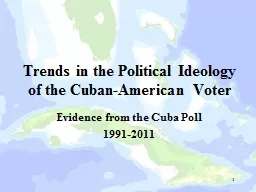

Evidence from the Cuba Poll 19912011 1 2 population culture Social organization Institutions Demographic Changes Ideologies Norms Values Beliefs Groups Classes Stratification Politics ID: 688983
Download Presentation The PPT/PDF document "Trends in the Political Ideology of the ..." is the property of its rightful owner. Permission is granted to download and print the materials on this web site for personal, non-commercial use only, and to display it on your personal computer provided you do not modify the materials and that you retain all copyright notices contained in the materials. By downloading content from our website, you accept the terms of this agreement.
Slide1
Trends in the Political Ideology of the Cuban-American Voter
Evidence from the Cuba Poll1991-2011
1Slide2
2
population
culture
Social organization
Institutions
Demographic
Changes
Ideologies
Norms
ValuesBeliefs
GroupsClassesStratification
PoliticsReligiousKinshipEducationEconomy
Social Dimensions of Change in Cuban MiamiSlide3
Next Few Minutes…
Trends in Cuban Migration, Residency and Naturalization.
How these trends have shaped Miami’s Latino demographics.
How these trends have shaped Cuban political ideology on US/Cuba relations.
Final note on Cuban-American political exceptionalism. You should walk away with a sense of the changing nature of Cuban voter opinion towards US/Cuba Relations and the forces that are ineluctably creating the changes.
3Slide4
Cubans Receiving Permanent Resident Status by Decades
4Slide5
Cubans Naturalized
2003-2012
5
2003
2004
2005
2006200720082009
201020112012Slide6
Comparative Rates of Naturalization of Selected Latino Groups
2003-2012
6
2003
2004 2005
20062007
2008200920102011
2012Slide7
Latino Origin Population
Percent of Total Population (2% or more) 2010
7Slide8
Miami
2,496,435
Non-Hispanic African descent
425,650
17%
Other Hispanic
31%
“Anglo”
383,551
15%
Cuban860,00035
%
<1994559,0065%1994>
Haitian 120,000
AA
Car
150,000
CA
212,542
SA
273,542
>
1994
301,00035%
Other
142,000Slide9
1990 Polls vs
2000 PollsAverage of ResponsesSupport for Embargo and Support for Dialogue
9Slide10
Establishing a Dialogue
10Slide11
Favor Continuing Embargo
11Slide12
Do you think that the United States should continue the trade embargo with Cuba or should the United States end the trade embargo and permit normal trade with Cuba?
12
Source:
WPO 2009Slide13
1990 Polls vs
2000 PollsAverage of ResponsesSupport for Selling Medicines and Unrestricted Travel
13Slide14
Allow companies to sell medicine to Cuba?
14Slide15
Allow companies to sell food to Cuba?
15Slide16
Should unrestricted travel from U.S. to Cuba be allowed (for all Americans)?
16Slide17
Should unrestricted travel by all Americans to Cuba be allowed or not
?
17Slide18
Do you favor or oppose the U.S. re-establishing diplomatic relations with Cuba?
18Slide19
Do you favor or oppose continuing the U.S. embargo of Cuba?
19Slide20
Registered as Republican, Democrat or Independent?
20Slide21
Voter Registration
Cubans in Miami2011
21Slide22
Among Multiple Identities- What is The Primary Identification among Latino Sub-Groups
Latino sub-groups in Florida
American
National Origin
Pan-ethnic
(Latino)
Cuban
27.0%
24.9%
38.4%
Puerto Rican
21.1
28.9
46.4
Mexican
7.8
36.4
47.3
Dominican
12.8
32.1
44.9
South American
24.5
32.7
34.7
Central American
22.5
43.7
29.6
Statistically significant @.055Slide23
LATINO GROUP PERCEPTIONS OF SOCIO-ECONOMIC COMMONALITIES
Thinking about issues like job opportunities, education or income, how much do
your ethnic subgroup
have in common with other Latinos or Hispanics? Would you say [ethnic subgroup] share a lot in common, some things in common, little in common, or nothing in common with other Latinos?
LATINO SUB-GROUPS IN FLORIDA
NONE/ LITTLE
SOME/ A LOT
Cubans
18.2%
71.2%
Puerto Ricans
13.2
80.2
Mexicans
19.4
72.1
Dominicans
14.1
80.7
South Americans
15.3
77.6
Central Americans
15.5
80.3
NOT STATISTICALLY SIGNIFICANTSlide24
LATINO GROUP PERCEPTIONS OF POLITICAL COMMONALITIES
Now thinking about things like government services and employment, political power and representation, how much do [ethnic subgroup] have in common with other Hispanics or Latinos? Would you say [ethnic subgroup] share a lot in common, some things in common, little in common, or nothing in common with other
LATINO SUB-GROUPS IN FLORIDA
NONE/ LITTLE
SOME/ A LOT
Cubans
18.6%
78.7%
Puerto Ricans
22.3
71.0
Mexicans
27.9
60.5
Dominicans
23.0
67.9
South Americans
34.7
56.2
Central Americans
33.8
59.2
Statistically significant @<.05